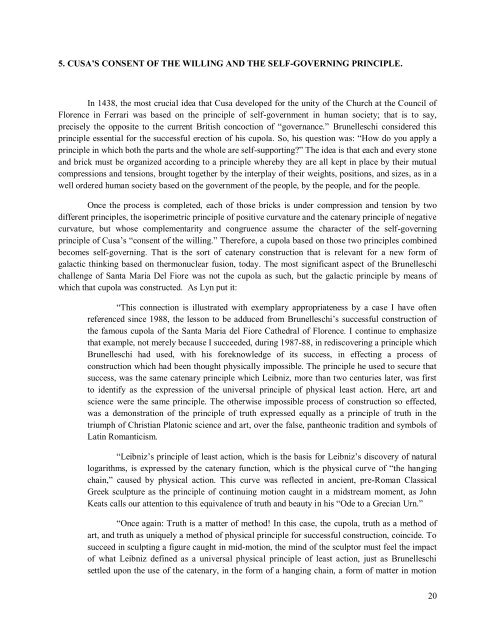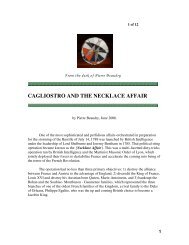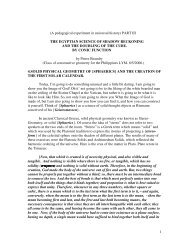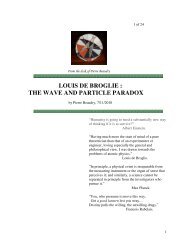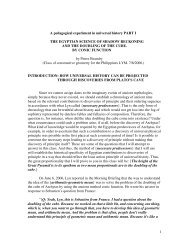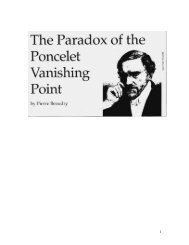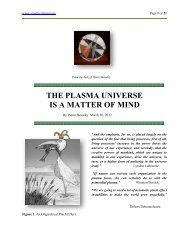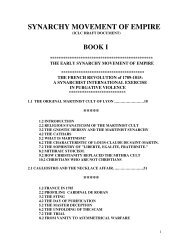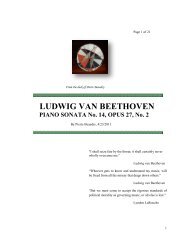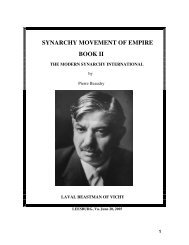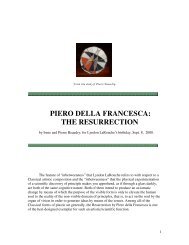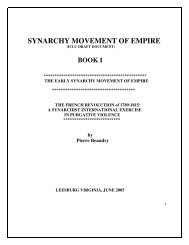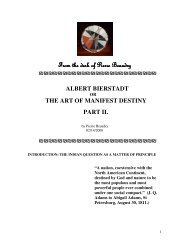filippo brunelleschi's mind and the catenary principle - Pierre ...
filippo brunelleschi's mind and the catenary principle - Pierre ...
filippo brunelleschi's mind and the catenary principle - Pierre ...
Create successful ePaper yourself
Turn your PDF publications into a flip-book with our unique Google optimized e-Paper software.
5. CUSA’S CONSENT OF THE WILLING AND THE SELF-GOVERNING PRINCIPLE.In 1438, <strong>the</strong> most crucial idea that Cusa developed for <strong>the</strong> unity of <strong>the</strong> Church at <strong>the</strong> Council ofFlorence in Ferrari was based on <strong>the</strong> <strong>principle</strong> of self-government in human society; that is to say,precisely <strong>the</strong> opposite to <strong>the</strong> current British concoction of “governance.” Brunelleschi considered this<strong>principle</strong> essential for <strong>the</strong> successful erection of his cupola. So, his question was: “How do you apply a<strong>principle</strong> in which both <strong>the</strong> parts <strong>and</strong> <strong>the</strong> whole are self-supporting?” The idea is that each <strong>and</strong> every stone<strong>and</strong> brick must be organized according to a <strong>principle</strong> whereby <strong>the</strong>y are all kept in place by <strong>the</strong>ir mutualcompressions <strong>and</strong> tensions, brought toge<strong>the</strong>r by <strong>the</strong> interplay of <strong>the</strong>ir weights, positions, <strong>and</strong> sizes, as in awell ordered human society based on <strong>the</strong> government of <strong>the</strong> people, by <strong>the</strong> people, <strong>and</strong> for <strong>the</strong> people.Once <strong>the</strong> process is completed, each of those bricks is under compression <strong>and</strong> tension by twodifferent <strong>principle</strong>s, <strong>the</strong> isoperimetric <strong>principle</strong> of positive curvature <strong>and</strong> <strong>the</strong> <strong>catenary</strong> <strong>principle</strong> of negativecurvature, but whose complementarity <strong>and</strong> congruence assume <strong>the</strong> character of <strong>the</strong> self-governing<strong>principle</strong> of Cusa’s “consent of <strong>the</strong> willing.” Therefore, a cupola based on those two <strong>principle</strong>s combinedbecomes self-governing. That is <strong>the</strong> sort of <strong>catenary</strong> construction that is relevant for a new form ofgalactic thinking based on <strong>the</strong>rmonuclear fusion, today. The most significant aspect of <strong>the</strong> Brunelleschichallenge of Santa Maria Del Fiore was not <strong>the</strong> cupola as such, but <strong>the</strong> galactic <strong>principle</strong> by means ofwhich that cupola was constructed. As Lyn put it:“This connection is illustrated with exemplary appropriateness by a case I have oftenreferenced since 1988, <strong>the</strong> lesson to be adduced from Brunelleschi’s successful construction of<strong>the</strong> famous cupola of <strong>the</strong> Santa Maria del Fiore Ca<strong>the</strong>dral of Florence. I continue to emphasizethat example, not merely because I succeeded, during 1987-88, in rediscovering a <strong>principle</strong> whichBrunelleschi had used, with his foreknowledge of its success, in effecting a process ofconstruction which had been thought physically impossible. The <strong>principle</strong> he used to secure thatsuccess, was <strong>the</strong> same <strong>catenary</strong> <strong>principle</strong> which Leibniz, more than two centuries later, was firstto identify as <strong>the</strong> expression of <strong>the</strong> universal <strong>principle</strong> of physical least action. Here, art <strong>and</strong>science were <strong>the</strong> same <strong>principle</strong>. The o<strong>the</strong>rwise impossible process of construction so effected,was a demonstration of <strong>the</strong> <strong>principle</strong> of truth expressed equally as a <strong>principle</strong> of truth in <strong>the</strong>triumph of Christian Platonic science <strong>and</strong> art, over <strong>the</strong> false, pan<strong>the</strong>onic tradition <strong>and</strong> symbols ofLatin Romanticism.“Leibniz’s <strong>principle</strong> of least action, which is <strong>the</strong> basis for Leibniz’s discovery of naturallogarithms, is expressed by <strong>the</strong> <strong>catenary</strong> function, which is <strong>the</strong> physical curve of “<strong>the</strong> hangingchain,” caused by physical action. This curve was reflected in ancient, pre-Roman ClassicalGreek sculpture as <strong>the</strong> <strong>principle</strong> of continuing motion caught in a midstream moment, as JohnKeats calls our attention to this equivalence of truth <strong>and</strong> beauty in his “Ode to a Grecian Urn.”“Once again: Truth is a matter of method! In this case, <strong>the</strong> cupola, truth as a method ofart, <strong>and</strong> truth as uniquely a method of physical <strong>principle</strong> for successful construction, coincide. Tosucceed in sculpting a figure caught in mid-motion, <strong>the</strong> <strong>mind</strong> of <strong>the</strong> sculptor must feel <strong>the</strong> impactof what Leibniz defined as a universal physical <strong>principle</strong> of least action, just as Brunelleschisettled upon <strong>the</strong> use of <strong>the</strong> <strong>catenary</strong>, in <strong>the</strong> form of a hanging chain, a form of matter in motion20


